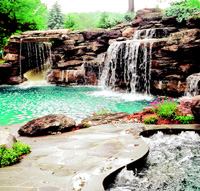Let’s make a bold declaration: When it comes to high-end, custom waterscapes, it is no longer acceptable to show what some professionals call the “white goods.”
That means no more white plastic hardware to clash with deck and pool materials. On these projects, white lids for skimmers or automatic fills, or white plastic deck drains should be a thing of the past. In addition, it’s time to move away from un-color-coordinated metallic cover-box lids. Even fittings inside the pool should not distract.
These items break up the fluidity of a flagstone deck or the depth and texture of a colored pebble interior. “When people are paying that kind of money, they don’t want the same thing everybody else has,” says Ken Whitlow, owner of WaterColors LLC in Lilburn, Ga. “If you’ve got a big, plastic white drain sticking out of the deck and it’s a nice limestone color, they’ll ask, ‘What could we do besides that?’”
In short, unless the pool or deck is white or an extremely light shade, you should see no white plastic anywhere. Here, we’ll discuss ways to eradicate this visual menace once and for all.
White skimmer lids are no longer a necessary evil. Builders have other options. On stone decks, Whitlow foregoes the manufactured lid altogether and simply cuts one out of the deck material. “We drill a hole in the center of it and put a little cutout for your finger,” he says. “Sometimes [the lid is] a circle, sometimes they’re square, depending on the shape of the skimmer.”
A product called Pour-A-Lid now exists to help create lids of stone or a cementitious material. It essentially provides the frame. The contractor only needs to cut the stone to fit or pour the cementitious deck material.
If pool builder Jeff Kearns wants to avoid a lid on the deck, he’ll use a front-loading skimmer. “A front-loading skimmer allows the basket to come out in the front versus the top,” says the president of Wildwood Aquatech Pools in Fresno, Calif. “But they carry maybe 30 percent less debris, and sometimes it’s difficult to get the debris out from the front.”
Deck drains. Whether in round or strip form, these items can wreak the same havoc when not color-matched.
Whitlow tries to avoid interrupting the deck with drains. If he can, he’ll just slant the slab toward grass or a planting bed at the standard slope of 1/8 to ¼ inch per foot.



